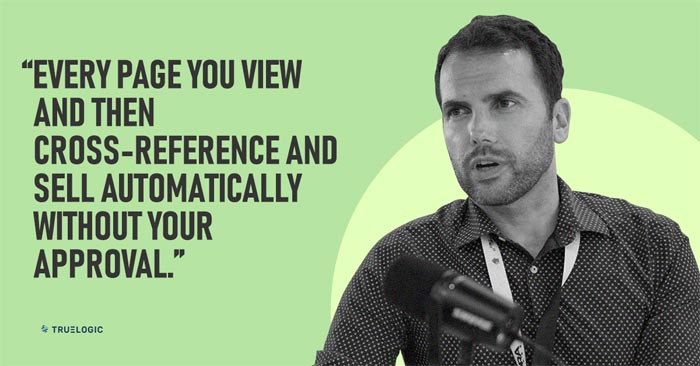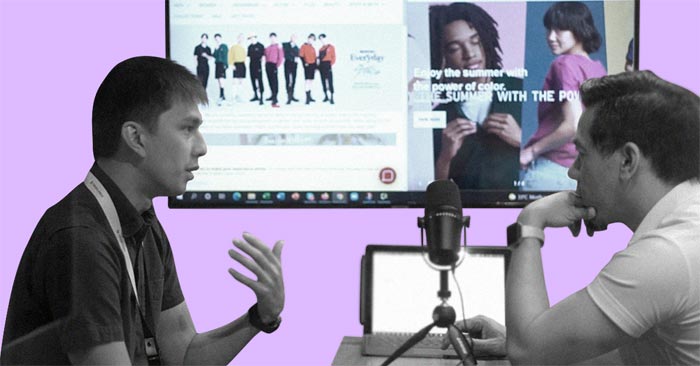Truelogic Episode 44 Recap: How to Win Your Audience with Storytelling

Vince Golangco, CEO of the top online magazine in the country, When in Manila, joins us in this Truelogic DX episode to share how his company has stayed on top of its game for over a decade.
He also shares its humble start, how he grew the team, and some of the growing pains they encountered in the beginning.
Vince also shares tips on choosing the right social media platforms for your business and how to grow your brand through storytelling.
Podcast Transcription:
Humble Beginnings of When in Manila
Berns San Juan: Hi Vince, thanks a lot for taking the time again to join us for the Truelogic DX podcast. And what I wanted to start the conversation off with was let’s talk beginnings. So if I’m not mistaken, When in Manila got started around 2009ish, right? So how did When In Manila get started?
Vince Golangco: So I am Vince Golangco, the founder and CEO right now, wheninmanila.com. We started with just me loving writing. I discovered that I loved writing in college and I kept writing. I had about ten blogs when I was living in the US. I was at San Diego State University, and I wasn’t sure what to take as a major. I switched majors, I was doing business, but I had too much numbers in accounting, and I’m the anti-Asian stereotype where I suck at math, all that accounting, and all that. Back then, I didn’t see communication as a major. But everyone communicates. Everyone collaborates.
But the other thing that I didn’t realize, the late, late, late in my life was that communication was my strength. I was good at communicating. I was a radio DJ, I’m an events host, I’m good at explaining things, and I’m good at voicing things out. I’m good at telling stories. And I didn’t know that was my strength, which is why I found it so easy that it wasn’t a real major to me.
And I know people like that where they think it’s so easy, but when someone else tries to do it, it’s so complicated. Architecture, Math, whatever it might be, the geniuses in those fields, to them it’s nothing.
Berns San Juan: And I think growing up right, that’s the thing. Like with the way we’re taught at school, nobody ever really teaches you that that’s a job. Being effective at communicating, and being able to get a story across is an actual job. In your case, it’s more than a job, it’s a business.
Vince Golangco: Absolutely. I guess it’s more on the creative side. And for a lot of schools, it’s very black and white, very businessy, not very creative. So I switched majors a few times, figured loved my writing classes, and kept writing. I had about ten blogs in the US. Because I separated them. I had a blog just for fun. I had my personal daily inspiration blog where I was trying to motivate myself every day, and I would write something to motivate myself, and I would just write it. I had a bunch of little blogs here and there.
The Birth of When in Manila
Vince Golangco: When I came to the Philippines, I was supposed to be here just for vacation. I was going to stay here for about six months and came up with the name with my friends, When In Manila. Sort of like the saying, ‘’When in Rome, do as the Romans do.” When In Manila do as the ‘Manilanians’ do, as the Filipinos do. It just sounded better than ‘When in the Philippines’ to me. It rolled off the tongue better. But technically, we have always been writing about the entire Philippines and anything relevant to Filipinos and the Philippines.
And upon writing, my articles did really well– the content did well pretty fast. And what I realized, later on, was that the Philippines doesn’t have a Yelp. Back then, before influencers, this was before Instagram. I hate saying that I’m older than Instagram, but before Instagram and all the other social media platforms took off. In the US, they really used Yelp. It never took off here. So if you’re not familiar, Yelp is pretty much Yellow Pages online. I’m not sure what they coined it from. But before anyone would go anywhere, any restaurant, watch any movie, or do anything, they would search on Yelp for reviews. ‘’Oh, is this restaurant good.’’ And since the Philippines didn’t have Yelp, anything you wrote about on a blog, Google really needed it like, ‘’Yeah, people are searching it.’’
Berns San Juan: It really picked it up because they didn’t have a database partner for businesses here. Not until pretty late, I think, Google My Business was already pretty advanced by that time. I remember it used to even be called Google+. But when it was Google+, it wasn’t in the Philippines.
Vince Golangco: But even that, they’ll just give you the information of the business. Not even reviews or more info or more. So even with that, but yeah, imagine it didn’t even have that. So definitely the blog did well from the start. So from there, I just kept writing. And for me, it was just fun, just because I loved it. Some days, I was writing 20, to 30 articles a day short.
Berns San Juan: Oh, my God. What’s a short article, Vince? From your standpoint.
Vince Golangco: A short article is sometimes a short video and then a couple of sentences, as long as it’s enough content. Because back then, technically, a short article would have been an Instagram post, but now there’s Instagram. So that’s it. So you have one quick picture and then a short description. That’s a short article, back then.
Berns San Juan: Of course, from the ground, you’re part of the creative team. You create the content. You’re a content creator. How much of that is true today? How much are you a content creator still today? How involved are you in the creatives of When In Manila till today?
Vince Golangco: I’m still very involved.
Berns San Juan: In Vince Golangco… let’s say, time chart, if we cut your time into ten units, you are what? Eight out of ten creative? Seven out of ten creative? How involved are you? Ten out of ten?
Vince Golangco: Sure. Because I post almost every day, still. A short something every day when I’m not handling the business side, but I’m discovering things every day. And then my girlfriend is also an influencer. She’s getting invited to all sorts of events and I tag along a lot. So I end up also posting about the events. And we like doing things together and discovering new things together. So it’s a mix of we’re enjoying it, plus it’s a little bit of work, but we get to enjoy it together. So I guess that’s what makes me do it even more and now.
Berns San Juan: It’s been a decade, and I think what most budding entrepreneurs realize is… and I’m speaking from experience myself. I put up my first business when I was 23, 24, which I eventually sold. But what I didn’t realize back then, and it doesn’t sound like you went through the same thing. I put up a business where we did commission artwork, like digital commission art when nobody did digital art way back when. Might have been 06’ 07’. Well, no, I did fantasy art. So I did. Elves, dragons, angels, online RPG players. They have money.
So I did art commissions, and we made good money out of it. But I really did it because it was what I was passionate about. And then before I realized it, I was like nine out of ten running the business. I’m buying computers, QAing the work of other artists, visiting them, uploading work, and talking to clients. And before I knew it, I was like, ‘”A one in ten artists, a nine in ten entrepreneurs,’’ which sort of caught me by surprise.
And in your case, what percentage of your time is spent being the driver of the business? And what part of your time is the businessman and what part of your business is creative? How much airtime does the creative guy get and how much airtime does the businessman get?
Vince Golangco: 90% of it is When In Manila, I think, maybe 80, 90. Because most of the other businesses I invest in, I always tell them, “I don’t want to be a decision-maker. I don’t want to be super involved. I want to help. I want to help promote it, marketing when I can. But I usually don’t like being involved.’’
Especially most of the other businesses I’ve invested in are not media. So I feel like they’re the experts. I like food, so I’ll invest in this restaurant. I like board games, so I’ll invest in the board game store. But as far as any logistics or whatnot, I tend to take a backseat. I help with the marketing. So work-wise, maybe 80, 90% is When In Manila the rest is just meetings and collaborations, but not really. Nothing too much.
Most Memorable Growing Pains in When in Manila – Cancel Culture
Berns San Juan: In over ten years, what are the most memorable growing pains you guys had to go through as When In Manila?
Vince Golangco: We’ve had our share. I think the hardest is the whole cancel culture thing. I really do not like cancel culture. I do understand that there may be times I did research, but from what I understand, it started based on people without power trying to take down that Hollywood guy who was abusing his power and raping women. So I guess something like that, yes, you would need to cancel culture. But today, it’s anything. Your food was delivered to you a minute late, and you’re like, ‘”Oh, cancel this restaurant. They did this, they did that.” And you had so many… it’s so hard to maneuver through the negativity. It really gets to my mental health and my whole team.
Some of the ones that people were mad at us and trying to cancel us. I remember one we got a very angry message about, ‘”Please stop saying, you guys are lying When In Manila, you keep saying you discovered this new beach for people to go, whatever, you did not discover that beach.’’ Very angry. In the cast, everything back then, we were still replying to almost every message as much as we could.
Today, I would have ignored that. Back then. We still replied, “Oh, what we meant was the writer discovered it for herself,’’ and wrote back again a long email in caps. What does that even effing mean? You guys have lied. Another one, even more recently is we got a very angry message again where vegetarian was telling us, ‘”It’s 2022 already, you guys should be putting warning labels on your posts about meat.’’ So it’s hard for us to think, “Is this a thing now?” We’ve never seen any warning labels on any other website. It’s like, “Okay, we respect your right to not like to eat meat,” but I don’t think that’s not a common thing.
Berns San Juan: Right. I’m not sure we should impose that on the carnivores that are part of our audience.
Vince Golangco: Exactly! It’s hard to maneuver. You use one wrong adjective, and one wrong punctuation mark, and people go crazy.
Berns San Juan: I think to put it into context though, Vince, why don’t we describe a world before cancel culture? I think creative people, found it a bit safer to produce content 12 years ago. What did a safe environment without cancel culture feel like? What was it like to be creative back then?
Vince Golangco: You could just post anything because it’s your opinion. You can disagree with people. It should be the way it is. But the problem is people, I mean, if they weren’t online and they were pissed off, sometimes it’s not even about what you did. That’s the thing. Sometimes they’re just pissed off because they’re having a bad day and they want to rant or they wanna fight something, and then they go online and you posted something that they disagree on, and boom. And if they happen to come up with an angle that other people might be able to relate to, then it goes viral.
And then now, but technically, even just 20 people, that is not something really big. But imagine 20 people continually very angry tweeting or posting like, “Oh, When In Manila is a piece of crap because they claim to discover.’’ That’s technically a lot in the grand scheme of things in the entire world. 20 people saying, ‘”Hey, you shouldn’t say you discovered this island because you did it.’’ That’s not a lot. But as the people behind that and getting these hate messages for our mental health and then having to decide, ‘”Hey, did we really do something wrong? Should we fix things? Did we do something that’s negative?’’ So it’s hard on the content creators.
Berns San Juan: Because I don’t think we were used to getting attacked for the content that we created or even the content we promoted. I don’t think that was ever a thing from 10, or 20 years ago. Everybody’s got the Internet as a megaphone to express their opinion.
Vince Golangco: I kind of like dark jokes and I love comedians. I miss it. None of them do it now. They’re all afraid of getting canceled.
Berns San Juan: So part of growing things was that I think the evolving taste of the culture. I don’t know how widespread it is in the Philippines, though. Has it become pretty widespread? I know that in the US. It’s a thing. Oh, wow. So that’s how I feel for you.
Vince Golangco: But that’s the thing. It’s widespread enough. And then if you’re not as a big giant, maybe super rich or a politician that has all these lawyers to go after every single thing, for content creators, it’s just instead of sending lawyers, you’re just sending your mental health away.
Video is King
Berns San Juan: If you could go back 10 years to Vince of 10 years ago, what advice would you give him?
Vince Golangco: I guess I would have posted more videos then. Video is king now. And I guess, 10 years ago, it was like, ‘”Hey, I know your first few videos didn’t get that many views, but just keep posting.”
Berns San Juan: I think that’s good advice. This is actually one of my opinions that did not age well, because I understood the Google algorithm back then, and it was super primitive back then. It looked at the text and gave more weight to things that were on the upper left side, and less weight to things on the lower right. It was very mathematical. And I always thought, “Uh, Google is never going to figure out the video.” And then here’s this platform and that platform, and they buy YouTube, and then there’s that. And you’re right. Video is becoming the king of content formats.
Choosing the Right Social Media Platform/Channel
Berns San Juan: Let’s talk about the present, given that advice. So, you guys, When In Manila is primarily a publication, And so you guys are online, you’re on the web, and the brand is primarily known for being the website. But you guys are so much more than that, you guys produce video content. So what’s the thought process when you guys were thinking about what other channels to venture into? Like were there no dissenting voices saying, ‘”Oh, if we do that, will we not decrease our traffic at When in Manila? Will we not do this? Will we not cannibalize our readership?’’ Were there any concerns like that when you were thinking of moving into other channels?
Vince Golangco: Oh, no, because it compliments each other. That’s never been a discussion.
Berns San Juan: Everybody just saw it. Everybody was on the same page the instant that idea flew on the table.
Vince Golangco: Well, I don’t think it was even an idea, because, from the start, every blog already had a Facebook page and a Twitter account. So it’s more on just deciding on when new social media comes out, it’s like, ‘’Okay, do we jump onto this?’’ Because, for us, we just recently, well, not just recently, but a couple of years ago, we had to decide, like, ‘”Hey, Twitter is kind of growing and TikTok, kind of growing pretty big. I think we should start posting more content there.” It’s more than that.
Berns San Juan: That’s a point of curiosity for me, actually. So how do you guys decide when you want to try a specific platform? How did you guys think about, ‘’Okay, TikTok is growing, we want to try that.’’ Is there a decision-making process that goes behind it? ‘’You know what? Let’s try TikTok.’’ I also think, by the way, for brands, because there are brands that listen to us for most of them, their challenges. But what would we even post on TikTok? So for them, it’s not just, okay, we get it, but it’s growing. But what would we even put there that’s relevant? So let’s start off with the first question for you guys, trying out a channel, how does that go?
Vince Golangco: I think it’s more, you just have your ear in the industry. You just sort of see that, hey, there are sites that are growing fast. It’s getting known globally. It was really more of just a trial, and then we did really well. Fortunately for us, for TikTok, we tried a few others that we thought were growing and are. One other we tried is Kumu. Unfortunately for us, we had a hard time with Kumu, and we weren’t able to continue. Really nice platform as well but they do mainly live streams, and we didn’t have anyone special. We were more behind the scenes, at least. So it was hard for us to go on air and be super like an event host type.
From what I understand, at least back then, a year ago or so, when we tried it, the accounts that did best were usually singers, and they would just sing for an hour or two with people. I don’t have anyone… Unfortunately, it wasn’t part of the job requirement to work for When In Manila.
Berns San Juan: Deciding on how to stay on the platform. So what’s the decision-making behind staying on the platform? How did you guys figure out, ‘’You know what? Twitter is really breaking well, for us. ’’
Vince Golangco: That was working well and was easy because pretty much the content we created. So we could create a time. There are times when we create specific content for TikTok, specifically for Twitter, but there are times when it’s just one piece of content. We post on all social media platforms just because different people are on different platforms. Like the younger generation, some of them are only on TikTok. They don’t like going on Facebook because that’s their family messenger app. Their mom and dad are there.
So the younger generation, only like TikTok. Other generations like both Twitter and Instagram, and some only like Facebook and whatever. So the more platforms are on, the better. So for us, just our posts were doing well. I personally love being on TikTok, so we just stayed on TikTok because it was very similar to the other social media platforms. But again, something like Kumu was completely different. So we had a hard time with that. So we tried, but then eventually, we weren’t able to keep up the account. Down the line, if it really still grows, then we may look into it.
Who is your favorite and memorable client?
Vince Golangco: So we have a lot. Every campaign we do is so amazing because you always have to think of something to make it stand out. But I think they’re really organic ones. My favorite is really early in When In Manila’s career, it wasn’t even sponsored. They didn’t invite me. So I was looking for a suit. I was really shopping. I found this one small suit place. This was before I decided to stay in the Philippines.
I’m being at suits and the doctor is the one who does the talking and the marketing, and the dad is the one who sews. And the dad has been sewing suits for, I think 30 years, over 30 years back then. And when he measured me, he said, ‘”Vince, I’m going to make the padding on your whichever shoulder on, the left side a quarter of an inch thicker than the right side because your shoulder is leaning a little bit to one side. Do you have scoliosis?’’ And my mind was blown. And you can see that? Like that quarter of an inch, because I do have, I do have very, very slight scoliosis. And he could see that. I’m like, ‘’Oh my God.’’ And I shared that in a blog.
Berns San Juan: That’s a pro.
Vince Golangco: They’re really good. I love their suits. I’m not just saying it, but I got my suits from them ever since. After that what I didn’t know, and Eileen, the daughter, told me years after she thanked me so much. She was like, “Vince, actually, when you came to our store, we were very close to closing down. We were probably a few months away. We were not getting good business. We’ve been around for a few months or a year’’ that they’ve been around and they weren’t getting good business. But after I wrote about them and until today, because every time I still keep asking them, “Are you still getting business from one of When In Manila?” And they’re like, “Yes.”
This was 10 years ago. Ever since then… so all my suits are free from them because I brought them so much business. And I barely wear suits because I’m creative. I don’t have that many business meetings, and it’s so hot here. I love wearing suits, but it’s so hot in the Philippines.
So I did contact them for a year. I did ask for a new suit, and they got sad. They messaged me. They’re like, ‘”Vince, you haven’t asked for a new suit in a year. Can we make you a new one?’’ I’m like,’’ But I have so many.’’ They’re like, ‘’No, Vince, we just want you to post about it because we were still getting business from When in Manila. We get so much business from you. You kept us alive.’’
So I think it was partial SEO, a mix of things. But again, there was no Yelp. So when you search for things on Google at that time, I guess I hit the right keywords for them. ‘Best suit in Manila?’ Something like that. They do best folk suits. So tailor-made exactly to your fit, and it was amazing. And we’ve been close friends ever since then.
What advice would you give a 20-something career person that is on the grind of things right now?
Vince Golangco: When I was in the grind back then, I loved quotes, so I had a couple of quotes. But as far as the grind, one of my favorite quotes was, “Do not judge each day by the harvest that you reap. Instead, judge each day by the seeds that you plant.” Meaning, today, so you’re in the grind today. You did the harvest damping. There were no fruits today. But if you planted 100 trees one day, those 100 trees are going to blossom and give you fruit and whatever. But make sure you’re planting seeds today. That way, one day you may reap that harvest. So, as long as you’re in the grind, keep grinding, keep planting seeds that may one day turn into this big tree for you and everyone around you.
What advice would you give people in the creative space?
Vince Golangco: For content creators, my advice is to always post every day. If you’re very serious about content creation, post three a day. If you’re getting into it slowly, one a day is okay. But if you’re very serious, three a day. And you’re going to ask, “What do I post?” Whatever. After you post, see what did well. Do more of that. See what didn’t do well. Adjust it. Try it again maybe or stop doing that. But see what did well, post more of that. Three a day. Find something easy for you to do that you can post regularly and a lot of and do. If you’re not a content creator, you’re in the marketing advertising space, work with influencers. Pick your influencers. I heard When In Manila is pretty good.
Berns San Juan: It resonates with the advice that I heard from Stephen King. His best advice to writers, he said, “Writers write. There is no muse.” I think that’s terrific. And you’re right. And as somebody that’s managed like 30 plus writers, because we have an army of writers, one of the things that would always happen on a one-on-one, because I try to talk to all of our employees is they tell me, “My biggest challenge would work is when my muse is not working with me.” I will get that from creative people.
Vince Golangco: Oddly enough, my video people never tell me that. My video people will tell me, ‘”No, not feeling it today.’’ But my writers are going to tell me “My muse is on vacation today.’’ I’m drawing up a blank.
Berns San Juan: And I think that’s the best advice, right? Like writers write. if you’re a content creator, post, this is what you do.
Vince Golangco: To take that to the next level, again, when people say I don’t have inspiration today. So that always happens. So that’s where the trick is with content creation, which is not to be too picky, especially in the beginning, and not to curate everything too much. You’re not trying to make the next Oscar right now with your 7-second TikTok post.
So in the beginning, when you’re starting your content creation career, just post. As long as it’s not negative, as long as you’re not hurting anyone, just post. Figure it out as you go along and then adjust. And then as you grow an audience, then you can start working on your quality then. It’s a quantity game in the beginning.
What advice would you give the young entrepreneurs that listen to the podcast?
Vince Golangco: I think it’s meet people, go out. I feel like I got a lot of inspiration whenever I meet someone and we would collaborate. So I think meet people and collaborate. So I think it’s a lot of inspiration coming from the people you meet. I love meeting people. I loved finding ways to work with them, finding ways to grow together with them, to work on something with them. So I would highly recommend that you guys go to events, go to networking events, try to meet people, find a mentor. And yeah, that’s one thing I also found. I found a bunch of mentors when I was meeting people.
Berns San Juan: Fantastic. And with that, I think I’ve run our time. But Vince, I’m going to thank you again. Guys, Vince Golangco, When In Manila. Thank you very much for spending 20-25 minutes with us.
Vince Golangco: Thank you for having me. If I can invite people, if they have a small business, if they have something worth featuring that they want to be featured on wheninmanila.com and our social media, just message us. You can message us on our social media or email hi.wheninmanila@gmail.com. And we’d love to try to feature you guys. And also, just if you want any personal advice or anything, you can follow me also @vincegolangco. And yeah, I’ll see you around.
Berns San Juan: Sounds great. Thank you very much. Thank you for joining us on another episode of Truelogic DX Podcast. Subscribe to our Spotify, Google, and Apple accounts and set up your alert for new episodes.










